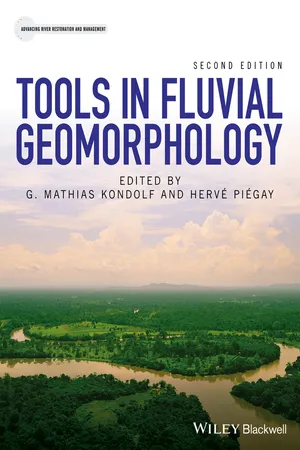
- English
- ePUB (mobile friendly)
- Available on iOS & Android
Tools in Fluvial Geomorphology
About this book
Fluvial Geomorphology studies the biophysical processes acting in rivers, and the sediment patterns and landforms resulting from them. It is a discipline of synthesis, with roots in geology, geography, and river engineering, and with strong interactions with allied fields such as ecology, engineering and landscape architecture. This book comprehensively reviews tools used in fluvial geomorphology, at a level suitable to guide the selection of research methods for a given question. Presenting an integrated approach to the interdisciplinary nature of the subject, it provides guidance for researchers and professionals on the tools available to answer questions on river restoration and management.
Thoroughly updated since the first edition in 2003 by experts in their subfields, the book presents state-of-the-art tools that have revolutionized fluvial geomorphology in recent decades, such as physical and numerical modelling, remote sensing and GIS, new field techniques, advances in dating, tracking and sourcing, statistical approaches as well as more traditional methods such as the systems framework, stratigraphic analysis, form and flow characterisation and historical analysis.
This book:
- Covers five main types of geomorphological questions and their associated tools: historical framework; spatial framework; chemical, physical and biological methods; analysis of processes and forms; and future understanding framework.
- Provides guidance on advantages and limitations of different tools for different applications, data sources, equipment and supplies needed, and case studies illustrating their application in an integrated perspective.
It is an essential resource for researchers and professional geomorphologists, hydrologists, geologists, engineers, planners, and ecologists concerned with river management, conservation and restoration. It is a useful supplementary textbook for upper level undergraduate and graduate courses in Geography, Geology, Environmental Science, Civil and Environmental Engineering, and interdisciplinary courses in river management and restoration.
Frequently asked questions
- Essential is ideal for learners and professionals who enjoy exploring a wide range of subjects. Access the Essential Library with 800,000+ trusted titles and best-sellers across business, personal growth, and the humanities. Includes unlimited reading time and Standard Read Aloud voice.
- Complete: Perfect for advanced learners and researchers needing full, unrestricted access. Unlock 1.4M+ books across hundreds of subjects, including academic and specialized titles. The Complete Plan also includes advanced features like Premium Read Aloud and Research Assistant.
Please note we cannot support devices running on iOS 13 and Android 7 or earlier. Learn more about using the app.
Information
Section V
Analysis of Processes and Forms: Water and Sediment Interactions
Chapter 11
Channel form and adjustment: characterization, measurement, interpretation and analysis
11.1 Introduction
11.2 Characterization and measurement
Table of contents
- Cover
- Title Page
- Copyright
- Table of Contents
- List of contributors
- Series Foreword
- Preface to the Second Edition
- Section I: Background
- Section II: The Temporal Framework: Dating and Assessing Geomorphological Trends
- Section III: The Spatial Framework: Emphasizing Spatial Structure and Nested Character of Fluvial Forms
- Section IV: Chemical, Physical and Biological Evidence: Dating, Emphasizing Spatial Structure and Fluvial Processes
- Section V: Analysis of Processes and Forms: Water and Sediment Interactions
- Section VI: Discriminating, Simulating and Modelling Processes and Trends
- Section VII: Conclusion: Applying the Tools
- Index
- End User License Agreement